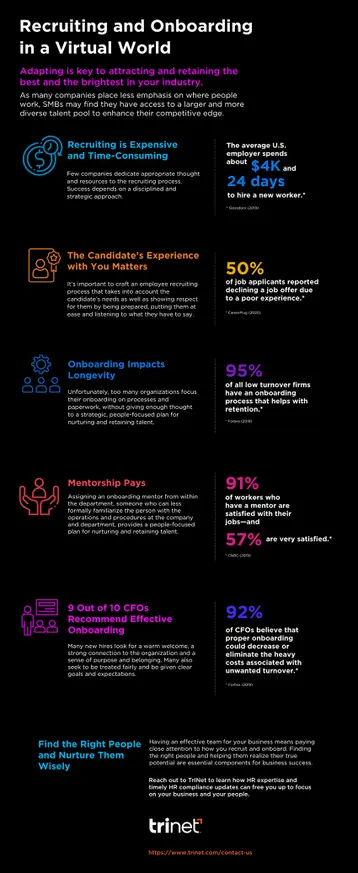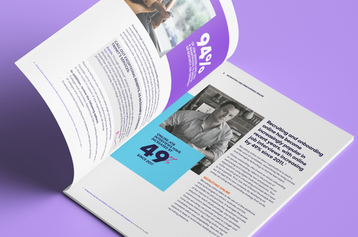
Table of contents
- 1.Prior to Day One
- 2.Day One
- 3.Continuing Through Day 90
- 4.Nurture Your People Wisely
Congratulations! You’ve found a qualified candidate who has accepted your employment offer. Now the onboarding process begins.
A positive onboarding experience is essential to setting your newly hired employees and your business up for success. An effective employee onboarding experience helps accelerate the learning curve, initiate engagement, reduce possible turnover and develop your leaders of tomorrow. People are your most valuable resource. And providing the best possible first impression will lead to an increased return on investment for all involved.
The Harvard Business Review reported that organizations with standardized onboarding processes increase retention by 50%.1 Given that the average U.S. cost-per-hire is $4,4252—it’s important to do what you can to keep the talent in whom you’ve invested.
Yet, surprisingly few companies dedicate appropriate thought and resources to the onboarding process. That may be because too many organizations focus their onboarding on processes and paperwork, without giving enough thought to a strategic, people-focused plan for nurturing and retaining talent.
Following are some best practices that apply to onboarding for nearly any industry.
Prior to Day One
- HR should create a new personnel file and other files as appropriate
- Prepare and send the new hire a personalized welcome note or video from leadership and co-workers
- Plan meaningful work for new employees to do during week one, so they feel busy and needed
- Announce to co-workers that new employees will be arriving
- Prepare the workstation or send all necessary equipment for remote work and have the new hire sign a company property or equipment form
- Remote work might require you to be a little more proactive—you might, for example, make sure the company laptop arrives the Friday before the Monday start date, so your employee is ready to go on day one
- Assign an onboarding mentor from within the department, someone who can less formally familiarize the person with the operations and procedures at the company and department
- According to a CNBC/SurveyMonkey Workplace Happiness Survey, 91% of workers who have a mentor are satisfied with their jobs—and 57% are very satisfied3
- Contrast that with the more than 4 in 10 workers without a mentor who say they’ve considered quitting their job in the past three months4
- Be clear about your company’s expectations
around important workplace routines, especially if the work will be remote; this includes:
- Productivity goals
- Breaks and meals
- Communication preferences
- Hours of work and recording of such hours, if applicable

Day One
- Welcoming a new employee is just as important as welcoming a new client whether online or in person
- Have your new employee’s supervisor or co-worker help them complete all relevant and required paperwork they have not already completed and review all relevant administrative procedures, performance expectations and compensation
- Ensure the new employee understands the core business, as well as the company and departmental culture and the history of the role the new employee has been hired to do—this can be part of a series of meetings with all relevant co-workers and supervisors
- If the work is remote and there is a group of new employees, you might create a day one class via video that enables a round of introductions
- These can then move into individual meetings that help new hires adjust to the social and performance aspects of their jobs
- Especially for remote work, vary tasks to avoid excessive hours spent on video calls
- Have one person or a group of people from the department take the new hire to lunch
- If the work is remote, you might schedule an informal zoom meal during lunch and have participants think ahead about how they can make the new hire feel at home
Continuing Through Day 90
While some organizations stop their onboarding process after the first week, doing so can leave new hires feeling confused and alone at work. In contrast, best practices indicate that employee onboarding programs should take place for at least 90 days to ensure new hires have the support they need to be productive. Many of the best onboarding programs create a program that encompasses the first year of work.
Whether 90 days or a year, both a supervisor and a mentor should have regularly scheduled meetings and check-ins to see if your new employee has questions, provide ongoing feedback and limit the risks of the new employee feeling isolated.
Nurture Your People Wisely
Because your people are your company’s biggest asset, it’s very important that you pay close attention to how you recruit and onboard. Finding the right people and helping them realize their true potential are essential components for business success.
2. Society for Human Resource Management, “Talent Acquisition Benchmarking Report (2017).
3. Laura Wronski, "Nine in 10 workers who have a career mentor say they are happy in their jobs," CNBC, accessed March 23, 2021.
4. Ibid
This communication is for informational purposes only; it is not legal, tax or accounting advice; and is not an offer to sell, buy or procure insurance.
This post may contain hyperlinks to websites operated by parties other than TriNet. Such hyperlinks are provided for reference only. TriNet does not control such websites and is not responsible for their content. Inclusion of such hyperlinks on TriNet.com does not necessarily imply any endorsement of the material on such websites or association with their operators.
TriNet Team
Table of contents
- 1.Prior to Day One
- 2.Day One
- 3.Continuing Through Day 90
- 4.Nurture Your People Wisely






